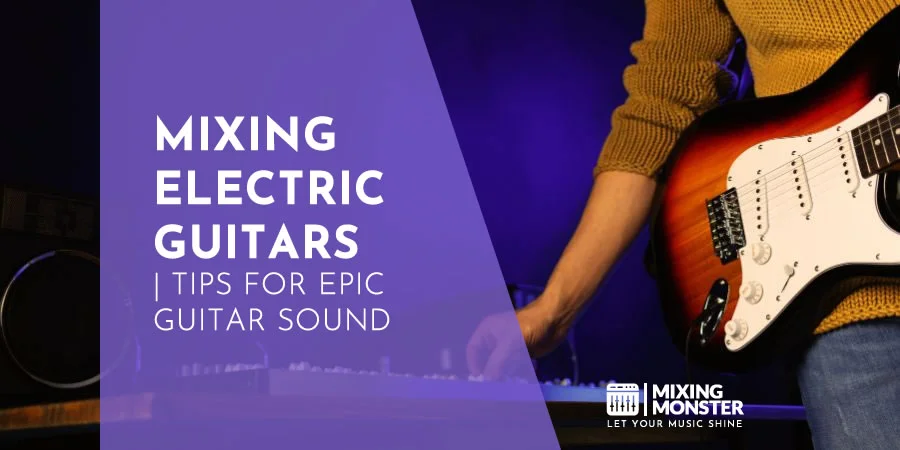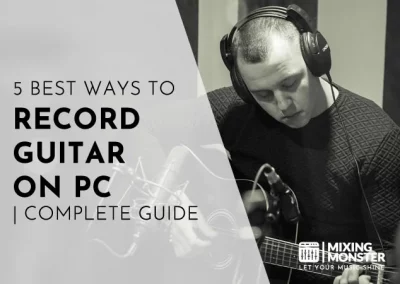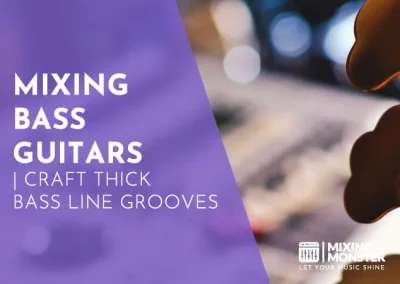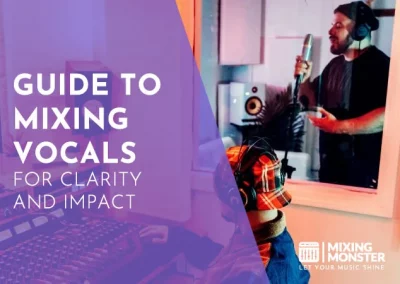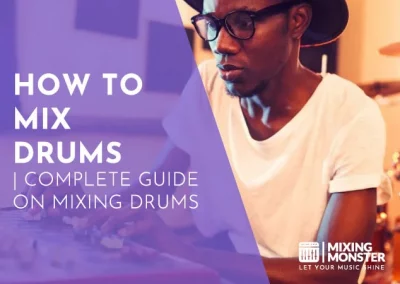Home > Blog > Mixing > Mixing Instruments
Disclosure: Some of the links below are affiliate links, meaning that at no additional cost to you, we will receive a commission if you click through and make a purchase. Read our full affiliate disclosure here.
Mixing electric guitars is a craft that transforms raw guitar recordings into powerful musical statements. The intricate process breathes life into a guitar track, enabling it to sit perfectly within a song. When done well, a mixed electric guitar can carry a tune to new heights, providing energy, atmosphere, and emotional depth. Understanding the fundamentals of mixing electric guitars is essential, whether you’re looking to achieve a crunchy rhythm section or a soaring lead.
Mixing electric guitars involves balancing levels, panning, EQ, compression, and adding effects, each step carefully sculpting the guitar’s sound to enhance its place in the mix. It is essential to prepare the tracks, lay them thoughtfully, and apply the proper techniques. Every choice made during the mixing process directly affects the final sound of the guitar, highlighting the importance of a systematic and informed approach.
Dive into this article to unlock the full potential of your electric guitar tracks. You’ll gain insights into the intricacies of EQ and filtering, learn how to achieve the perfect balance with compression, and explore creative effects that will add a unique touch to your sound. By the end, you’ll know to finalize your electric guitar mix confidently, ready to leave an indelible mark on your listeners’ ears.
KEY TAKEAWAYS:
- Mixing affects an electric guitar’s presence and tone within a track.
- A systematic approach is crucial for achieving a professional-sounding mix.
- Knowledge of advanced techniques can significantly enhance the guitar’s impact.
Table Of Contents
1. Basics Of Mixing Electric Guitars
2. Preparing Electric Guitar Tracks For Mixing
3. Layering And Panning Electric Guitars
4. Electric Guitar EQ And Filtering Techniques
5. Utilizing Compression For Electric Guitar Balance
6. Adding Spatial Effects To Electric Guitars
7. Electric Guitar Amplification And Saturation
8. Creative Electric Guitar Effects And Automation
9. Fixing Electric Guitar Frequencies And Separation
10. Finalizing The Electric Guitar Mix
11. FAQ

1. Basics Of Mixing Electric Guitars
Mixing electric guitars balances their presence within a track while respecting the mix. Your main goal is to achieve clarity and distinction for each guitar part.
Guitar Gain Staging
Begin by setting appropriate levels for each guitar track. Proper gain staging is crucial to avoid clipping and ensure each guitar track has space in the mix. Keep an eye on your meters and strive for a clean signal without pushing into the red.
Guitar Tone And Frequency Spectrum
Electric guitars typically reside in the midrange of the frequency spectrum. However, it would be best to sculpt their tone to fit within the context of the track.
High-Pass Filter:
Apply a high-pass filter to eliminate unnecessary low-end rumble that can muddy the mix. A starting point can often be around 80 Hz but adjust according to the desired tone.
Presence:
Slight 6 – 10 kHz reductions for rhythm guitars can allow lead parts to stand out.
Guitar Volume And Balance
Your electric guitar’s volume should complement the other instruments. Use faders to adjust levels, ensuring each guitar part is audible without overpowering the mix’s balance.
Guitar Panning
For a wider soundstage, pan rhythm guitars slightly to the sides and keep lead or intricate parts centered as needed. Effective panning helps define each guitar’s place in the mix, creating a more immersive listening experience. For strategies on panning and differentiating parts, consider the approach at Audio Spectra.
2. Preparing Electric Guitar Tracks For Mixing
Preparing your electric guitar tracks before mixing ensures the best possible sound. A well-prepared track can save time and allow for more creative choices during mixing.
- Begin with high-quality recordings.
- Use a trusted microphone such as the Shure SM57 to capture the clarity and punch of your electric guitar.
- Record a DI (Direct Input) signal to provide more flexibility later.
Gain Structure:
Pay careful attention to gain structure. Ensure that your recordings are at a healthy level without clipping. It’s easier to add gain than to repair a distorted track.
Track Labeling:
Properly label each track to keep your session organized. This might include noting the microphone placement, the type of guitar, and whether the track is rhythm or lead.
Guitar Track Preparation Checklist
- Inspect tracks for any noise or unwanted artifacts.
- Trim silence at the beginning and end.
- Tune the guitar before recording each take.
- Check phase alignment if using multiple microphones.
- Apply a gain plugin if necessary to adjust levels.
- Consider a high-pass filter to remove low-end rumble.
3. Layering And Panning Electric Guitars
Layering and panning are fundamental techniques in mixing electric guitars. They create spatial dimension and maintain clarity in your mix, especially when dealing with multiple guitar tracks.
Creating Width With Stereo Panning
When working with stereo panning, it’s crucial to consider the stereo field as a space that your instruments will occupy. Rhythm guitars often benefit from being panned left and right to create a sense of width.
This is a simple yet effective way to add dimension to your mix. For instance, by panning one rhythm guitar 30% left and another 30% right, you give your track a broader, more enveloping sound.
Maintaining Balance Between Multiple Electric Guitars
Balancing multiple electric guitars ensures that each part has its own space. Your goal is to achieve an even distribution across the stereo field. If you pan one guitar hard left, consider panning another guitar hard right to maintain balance.
However, always use your ears—sometimes counterbalancing with another instrument or leaving some space unoccupied can lead to a more dynamic mix.
Mixing Lead And Rhythm Electric Guitars
The lead instrument, often an electric guitar, typically occupies a prominent place in the mix. Keeping the lead relatively centered but with a slight pan to complement the rhythm guitars is familiar—it should cut through without clashing.
Remember, the relationship between lead and rhythm guitars is a dance of give and take; they should work together to support the overall track, not fight for the spotlight.
4. Electric Guitar EQ And Filtering Techniques
Refining the electric guitar’s EQ in the mixing phase is vital to fit it seamlessly within a track. Specific methods for cutting unwanted frequencies and boosting favorable ones can significantly enhance the guitar’s presence and clarity.
Cutting Offending Electric Guitar Frequencies
Implementing a high-pass filter can effectively tackle issues with muddiness or unwanted noise in your electric guitar track. Start at around 80Hz and adjust upward to potentially 200Hz if necessary to clear out low-end rumble.
Identifying and cutting offending frequencies—those that cause muddiness or harshness—requires careful listening, typically between 250-500Hz for muddiness and around 3kHz for harshness.
Enhancing Electric Guitar Tone With Additive EQ
Additive EQ should be employed to embellish the tone of your electric guitar. Boosting between 250-500Hz adds warmth and body while accentuating around 1kHz-3kHz can increase the pick sound and presence. Applying a high shelf around 10kHz can add air and sparkle to a clean electric guitar tone.
To sum the practices concisely, consider the following table:
| Frequency Range | Technique | Purpose |
|---|---|---|
| Below 80-200Hz | Apply High-Pass Filter | Remove low-end rumble |
| 250-500Hz | Cut to reduce muddiness | Enhance clarity |
| 250-500Hz | Boost to add body and warmth | Improve tone quality |
| 1kHz-3kHz | Boost or cut for pick sound | Adjust presence / harshness |
| Above 10kHz | Apply High Shelf | Add airiness to the tone |

5. Utilizing Compression For Electric Guitar Balance
Compression is a fundamental tool in your mixing arsenal for taming the dynamic range of electric guitar recordings. When used correctly, it can even out the levels between the quietest and loudest parts, ensuring a consistent sound.
Compression is vital whether you’re dealing with a lead guitar that must cut through the mix or a rhythm guitar that must sit perfectly alongside other instruments.
Setting Up Electric Guitar Compression
To achieve a well-balanced electric guitar mix, start by setting the threshold at a level where compression begins just as the guitar goes above average volume. This is a delicate balance; too aggressive and you’ll squash the life out of your performance; too subtle and you might not notice any effect.
Here’s a straightforward guide on the general settings for different electric guitar roles in your mix:
| Guitar Role | Ratio | Attack (ms) | Release (ms) | Notes |
|---|---|---|---|---|
| Clean Rhythm | 2:1 – 4:1 | 20 – 40 | 200 – 400 | Preserves natural dynamics while controlling peaks |
| Crunch Rhythm | 4:1 – 6:1 | 10 – 30 | 150 – 300 | Adds punch and presence |
| Lead Guitar | 3:1 – 5:1 | 5 – 15 | 100 – 200 | Ensures solos cut through mix without spiking |
Consider the attack and release settings— they are critical to preserving the guitar’s transients and natural sustain. A faster attack can clamp down on transients too quickly, so a moderate attack time is usually recommended, especially for preserving the bite of a lead guitar.
Conversely, the release time determines how quickly the compression stops affecting the signal after it falls below the threshold. A tailored release time prevents the sound from being overly compressed and unnatural.
6. Adding Spatial Effects To Electric Guitars
Implementing Electric Guitar Reverb For Depth
Reverb creates the illusion that your guitar is playing in a physical space, which can be as intimate as a small room or as vast as a cathedral. When applying reverb to the electric guitar, consider the following types and settings to maintain clarity while providing depth:
- Room Reverb:
Mimics the sound of a small space. Use short decay times and a low wet/dry mix to add a subtle ambiance. - Plate Reverb:
Offers a denser sound, perfect for vintage or retro vibes. Moderate the decay setting to avoid overwhelming the mix. - Hall Reverb:
Is ideal for a grand, spacious effect. It is best used sparingly and with extended solos or lead parts decay times. - Spring Reverb:
Known for its distinctive twang and often associated with surf rock tones. Adjust the mix to taste, ensuring it complements the track.
Remember to listen to the reverb in the context of the entire mix. Too much reverb can muddy your sound, while too little may make the guitar feel disconnected.
Using Electric Guitar Delay For Texture
Delay can be a rhythmic echo or a subtle thickening agent to your guitar’s sound. Here are ways to use delay effectively:
- Slapback Delay:
A single, short echo that adds fullness to each note. Keep the feedback low and the delay time under 200ms for the best effect. - Echo Delay:
Longer repeats can add a sense of rhythm to your playing. Set the feedback to allow for several bounces and sync the delay time with the song’s tempo for cohesion. - Dotted Eighth Delay:
A dotted eighth delay can be magical for a U2-like rhythmic texture. Match the delay time with your track’s tempo and adjust the mix level so it doesn’t overshadow the dry signal.
Utilize these delay types to enhance the context of the guitar part, whether to provide backbone or to sculpt the texture of the sound in your mix.
7. Electric Guitar Amplification And Saturation
In electric guitar production, the marriage of amplification and saturation is pivotal in crafting the guitar’s tone. By carefully adjusting your amplifier settings and deliberately applying distortion, you refine the sound for the desired impact.
Choosing The Right Guitar Amplifier Settings
To get started:
- Familiarize yourself with your amplifier’s basic controls, which typically include gain, bass, mid, treble, and presence.
- Adjust the gain to set the initial level of distortion—higher settings yield a more distorted sound.
- Balance your bass, mid, and treble to mold the character of the guitar tone.
Bass adds thickness, mid controls the body, and treble affects the sharpness and clarity. Use the presence control to adjust the higher frequencies and add edge to the sound.
- Gain:
Determines the amount of distortion. - Bass/Mid/Treble:
Shapes the EQ spectrum. - Presence:
Enhances upper-frequency clarity.
Dialing In Distortion And Saturation
With your amplifier settings dialed in, you’ll want to fine-tune to achieve the right saturation level. Saturation enriches the guitar tone by adding harmonic complexity and can vary from a slightly warm, tube-driven glow to a heavy, distorted crunch.
Depending on the genre, you may opt for a subtle saturation to enhance string separation and dynamic playing or increase it for more aggressive styles. Remember, too much saturation can mask the nuances of your performance, while too little may leave the sound flat and uninspiring.
When seeking grit and aggression, saturation can be a game-changer.
- Experiment with low to high saturation levels.
- Aim for harmonic richness without losing string clarity.
- Adjust to complement your playing style and genre.
8. Creative Electric Guitar Effects And Automation
This section will teach you how to enhance electric guitar tracks by effectively applying effects and automation. These techniques transform your raw guitar sounds into dynamic and engaging parts of your mix.
Utilizing Electric Guitar Pedals And Effects
Electric guitar pedals and effects are essential for sculpting your guitar’s tone.
- Distortion/Overdrive:
These pedals add grit and intensity, essential for genres like rock and metal. Create classic sounds by experimenting with stomp-box presets or going analog for more authenticity. - Modulation:
Chorus, flanger, and phaser effects can give clean guitar parts life and provide movement and width. - Ambiance:
Reverb and delay pedals contribute to the sense of space and depth. Remember to adjust the decay times to fit the genre – smaller spaces for tight mixes and larger ones for airy, open textures.
Experiment with presets to find a starting point, then tweak the settings to fit your track’s context. Consider reamping your guitar tracks; this process allows you to play back recorded guitar through amplifiers and effects, allowing you to shape the sound further.
Crafting Dynamics With Automation
Automation is the process of programming real-time control over various parameters in your Digital Audio Workstation (DAW).
- Volume Automation:
Allows you to create swells or fades, accentuate particular phrases, or ensure consistent levels throughout the track. - Effect Parameters:
Automate the mix control of a reverb pedal or the tremolo rate to add variety and interest to different song sections.
By strategically using automation, you craft a performance that breathes and evolves, making your guitar tracks feel more ‘alive.’ Automation also allows precise control over effects and levels, which can help manage dynamics and keep the listener engaged.
9. Fixing Electric Guitar Frequencies And Separation
When mixing electric guitars, achieving clarity and separation among instruments is paramount. Your EQ decisions have a significant impact on the presence and power of the guitar in the mix.
Low-end management is crucial to avoid muddiness. A high-pass filter removes unnecessary sub-frequency content, typically below 100 Hz, allowing room for the bass and kick drum.
For presence, subtle boosts between 1 and 3 kHz can enhance the guitar’s definition without making it harsh. Be cautious with these boosts to avoid competing with vocals.
Now, let’s look at expected problematic frequencies:
| Frequency Range | Problem | Solution |
|---|---|---|
| 200–250 Hz | Can cause muddiness | Cut to add clarity, especially in busy mixes |
| 400–600 Hz | Can sound boxy or nasal | Cut to remove honkiness, improve separation |
| 800 Hz – 1 kHz | Overemphasis can be tiring to the ear | Gentle cut to smooth out the sound |
| 2 kHz – 5 kHz | Harshness, especially with distortion | Careful cut to tame harshness without dulling |
| 7 kHz – 10 kHz | Excessive “fizz” | Cut to reduce noise, be subtle to maintain life |
10. Finalizing The Electric Guitar Mix
As you approach the final stage of your mix, make sure the electric guitars sit perfectly within the mix. They should complement the song’s dynamics and overall sonic landscape, accentuating their role without overpowering other elements.
Key Takeaways For Mixing Electric Guitars
- Assess The Entire Mix:
Listen to the entire mix before making final adjustments to your electric guitars. Make final volume tweaks to ensure that every part is audible. Also, ensure the guitars maintain their defining role without overshadowing the mix. - Volume Balance:
Adjust the volume of the electric guitars to make them sound bigger or more intimate, depending on the desired effect. Remember that subtlety is key; even small changes can significantly impact the mix. - EQ Adjustments:
Make any final equalization tweaks. For example, cut the rhythm guitar in the 6 – 10 kHz range to allow the lead to stand out. You can also boost around 500 Hz to add body to the mix. - Harmonics And Saturation:
Add a touch of harmonics or light saturation to help the guitars cut through the mix. This will help them achieve a fuller sound without increasing volume excessively. - Effects And Panning:
Judiciously apply spatial effects like reverb and delay. Also, panning effectively places the guitars in the stereo field. This can make the mix sound larger and more dynamic. - Final Listening:
Conduct a critical listening session on different systems to ensure the mix translates well everywhere, from studio monitors to earbuds.
In mixing electric guitars, you aim to preserve the instrument’s character while ensuring it enriches the entire mix. Balance and clarity are paramount, ensuring each strum and note fulfills its role within the track.
Happy guitar mixing!
11. FAQ
1) What are some essential tips for beginners who are mixing electric guitars?
For beginners, it’s essential to understand that electric guitar mixing starts with good EQ and thoughtful use of effects. It’s common to cut low frequencies to reduce muddiness and to use compression sparingly to control dynamics without squashing the life out of your guitar sound.
2) Can you provide a cheat sheet for mixing electric guitar tracks?
Effective electric guitar mixing balances EQ, compression, and reverb. Cut below 80 Hz to eliminate rumble, boost around 500 Hz for body, and consider slight cuts in the upper midrange around 2-3 kHz to reduce harshness.
3) What should be included in an electric guitar mixing chain?
Your mixing chain should typically include EQ to shape tone, compression to even out dynamics, and sometimes reverb or delay for spatial effects. Sometimes, a touch of overdrive or saturation is added for warmth and presence.
4) What are the best practices for mixing electric guitar in DAWs like FL Studio?
When mixing in DAWs, use the software’s built-in plugins to tweak the electric guitar sound. Also, adjust panning to create space in the mix, and automate volume and effects to highlight essential parts of the performance.
5) How do you approach mixing electric guitar for live performances?
Focus on midrange frequencies that help your guitars cut through the mix for live performances. Limit reverb and delay, as natural acoustics will impact the sound. Live mixing often requires real-time adjustments for changing conditions.
6) How do you effectively mix lead and rhythm electric guitars?
Establish separation by EQ-ing slightly different frequencies to mix lead and rhythm guitars. Panning can also help them create distinct spaces. Carve out space in the rhythm guitar’s frequency spectrum to ensure the lead guitar has enough presence.

